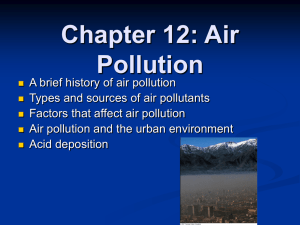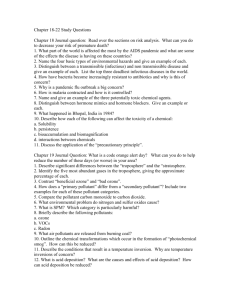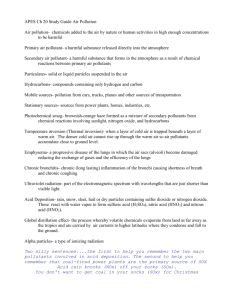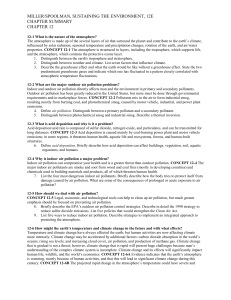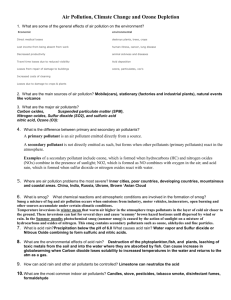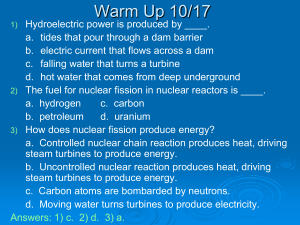Chapter17notes
advertisement
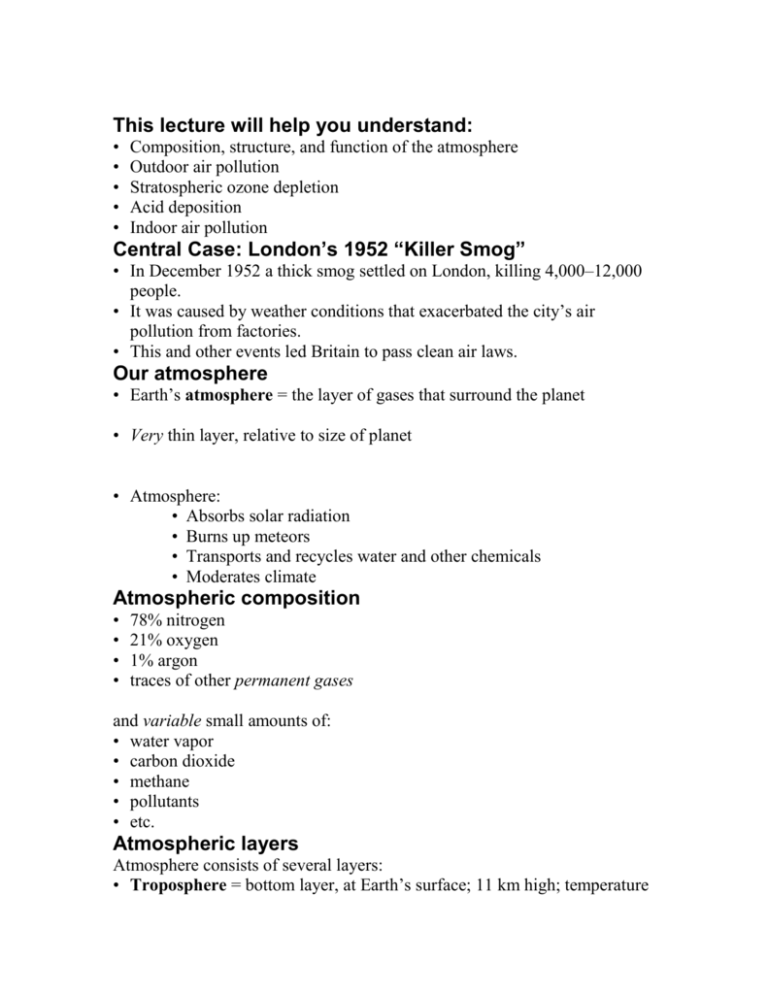
This lecture will help you understand: • • • • • Composition, structure, and function of the atmosphere Outdoor air pollution Stratospheric ozone depletion Acid deposition Indoor air pollution Central Case: London’s 1952 “Killer Smog” • In December 1952 a thick smog settled on London, killing 4,000–12,000 people. • It was caused by weather conditions that exacerbated the city’s air pollution from factories. • This and other events led Britain to pass clean air laws. Our atmosphere • Earth’s atmosphere = the layer of gases that surround the planet • Very thin layer, relative to size of planet • Atmosphere: • Absorbs solar radiation • Burns up meteors • Transports and recycles water and other chemicals • Moderates climate Atmospheric composition • • • • 78% nitrogen 21% oxygen 1% argon traces of other permanent gases and variable small amounts of: • water vapor • carbon dioxide • methane • pollutants • etc. Atmospheric layers Atmosphere consists of several layers: • Troposphere = bottom layer, at Earth’s surface; 11 km high; temperature decreases with altitude • Stratosphere = next layer up (11–50 km); temperature increases with altitude; contains “ozone layer” • Mesosphere = third layer up (50–90 km); temperature decreases with altitude • Thermosphere = top layer (90–500 km); very thin air; mostly lightweight elements; very hot; ionic radiation Atmospheric layers Temperature and other characteristics vary with altitude. Ozone layer • Not really a layer, but a region of higher-than-normal ozone concentrations (which are still very low) • ~17–30 km altitude • Absorbs ultraviolet (UV) radiation from sun, protecting organisms on surface from radiation damage Atmospheric properties • Atmospheric pressure = weight per unit area of air being pulled down by gravity (is less at higher altitudes) • Relative humidity = ratio of water vapor air contains relative to how much it could contain at that temperature • Temperature = air is warmed by the sun; temperature varies with altitude, location, time of day Pressure, density, and altitude • Gravity pulls most air molecules close to Earth’s surface, so air density is greatest near the surface. • Atmospheric pressure is the greatest near the surface because most molecules are above. The sun’s energy heats the atmosphere … and does so differentially at different latitudes. The sun and Earth’s tilt create seasons The sun drives weather in the troposphere Solar heating establishes convective circulation, circular currents in which warm air rises and cool air falls. Weather and climate • Weather = local physical properties of the troposphere, including temperature, pressure, humidity, cloudiness, wind • Climate = pattern of atmospheric conditions across large geographic regions over long periods of time (seasons, years, millennia) • “Climate is what we expect; weather is what we get.”—Mark Twain Weather produced by interacting air masses • Warm front = boundary where warm air mass displaces cold air mass • Cold front = boundary where cold air mass displaces warm air mass • High-pressure system = contains high-pressure air that descends • Low-pressure system = contains low-pressure air that rises Warm and cold fronts • Warm front’s warm air rising over cool air creates moderate precipitation. • Cold front’s cool air wedging under warm air forces warm air upward, causing heavy precipitation. Thermal inversion • Thermal inversion = natural occurrence that can exacerbate air pollution locally • Inversion layer = band of air in which temperature rises with altitude Global climate patterns • … result from differential heating of Earth’s surface… • …and from gigantic convection currents called Hadley cells, Ferrel cells, and polar cells. Global convection currents Global wind patterns • These three types of cells also influence wind patterns near the ground. • The Coriolis effect (planet’s rotation causes land at the equator to spin more quickly than temperate land) causes north-south winds to appear to be deflected, and to curve. Outdoor air pollution • Air pollution = material added to the atmosphere that can affect climate and harm organisms, including humans • Air pollution can come from human-made chemicals and causes, but the majority is from natural sources. • Government policy and improved technologies have helped diminish outdoor or ambient air pollution substantially in developed but not developing countries. Natural sources of air pollution Artificial sources of air pollution Human-caused air pollution includes: • Point sources = specific spots where large amounts of pollution are discharged (factory smokestacks) • Non-point sources = diffuse, often made up of many small sources (charcoal fires from thousands of homes) Artificial sources of air pollution Human-caused air pollution includes: • Primary pollutants = emitted into troposphere in a directly harmful form (soot, carbon monoxide) • Secondary pollutants = produced via reaction of substances added to the atmosphere with chemicals already present in the atmosphere (ozone in troposphere) Clean Air Act legislation Major air pollution legislation: • Clean Air Act of 1970: • Set stricter standards than previous laws • Imposed emissions limits • Provided research funds • Enabled citizens to sue violating parties • Clean Air Act of 1990: • Strengthened previous regulations • Introduced emissions trading for sulfur dioxide Six “criteria pollutants” The EPA closely tracks six major types of pollutants according to national ambient air quality standards: • Carbon monoxide (CO) • Sulfur dioxide (SO2) • Nitrogen dioxide (NO2) • Tropospheric ozone (O3) • Particulate matter • Lead CO / SO2 / NO2 • Carbon monoxide (CO) = colorless, odorless gas from vehicle exhaust and other sources; dangerous—prevents oxygen uptake • Sulfur dioxide (SO2) = colorless gas from coal burning for electricity and industry; contributes to acid precipitation • Nitrogen dioxide (NO2) = foul-smelling red gas from vehicle exhaust, industry, and electricity generation; contributes to smog and acid precipitation O3 / Pb / particulate matter • Tropospheric ozone (O3) = colorless gas; secondary pollutant from sunlight, heat, nitrogen oxides (NOx), and C-containing chemicals; contributes to smog; harmful to living tissues • Lead (Pb) = metal in atmosphere as particulate; from gasoline additive, phased out in 1980s; diverse health impacts, all bad • Particulate matter = any solid (or liquid) particles small enough to be carried aloft in air; dust, soot, sulfates, nitrates; causes respiratory damage Six “criteria pollutants” Emissions of all of these, especially lead and carbon monoxide, have substantially declined since 1970. Volatile organic compounds • “VOCs” are regulated by many governments. • Large group of potentially harmful carbonchemicals used in industrial processes. • Hydrocarbons are one example. • About half are human-made, half natural. containing • VOCs contribute to smog, produce secondary pollutants. Toxic air pollutants • Toxic air pollutants = chemicals known to cause serious health or environmental problems • Include substances known to cause cancer and reproductive defects, and substantial ecological harm • Most produced by human activities • 188 toxic air pollutants are regulated under the 1990 Clean Air Act. Industrial smog • Smog from industrial pollution, fossil-fuel combustion • The kind that blanketed London in 1952 • “Gray air smog” • Contains soot, sulfur, CO, CO2… Industrial smog The U.S. had its own “killer smog” from industrial pollution. Shown is Donora, Pennsylvania, in 1948, at mid-day. Subsequent demand for legislation against pollution made U.S. air much cleaner. Industrial smog Chemistry of industrial smog: • Burning sulfur-rich oil or coal creates SO2, SO3, sulfuric acid, ammonium sulfate. • Carbon leads to CO2 and CO. Photochemical smog • Smog from reaction of sunlight with pollutants • The kind that blankets so many American cities today • “Brown air smog” • Contains tropospheric ozone, NO2, VOCs, 100 more… • Hot sunny days in urban areas create perfect conditions. Photochemical smog • Mexico City and many of the world’s cities suffer from the brownish haze of photochemical smog. • Inversion layers and mountains can trap smog over certain cities. Photochemical smog Chemistry of photochemical smog: • Nitric oxide starts a chain reaction. • Reaction with sunlight, water vapor, hydrocarbon, results in over secondary pollutants. 100 Stratospheric ozone depletion • Ozone at low altitudes = beneficial layer protecting us from UV radiation • Ozone layer— ~ 12 parts per million in lower stratosphere—is enough to absorb UV and protect us. • But in the 1960s scientists noticed ozone concentrations were dropping. Stratospheric ozone depletion • In 1974, Sherwood Rowland and Mario Molina pegged the blame on chlorofluorocarbons (CFCs). • They won the Nobel Prize for this scientific detective work. • CFCs = human-made molecules in which hydrogens of hydrocarbons are replaced by chlorine and fluorine atoms • Mass-produced by industry, in refrigerants and consumer products like aerosol sprays Stratospheric ozone depletion • In 1985, the “ozone hole” was detected over Antarctica. • Ozone levels had declined 40–60% over the previous decade. Stratospheric ozone depletion CFCs persist in the stratosphere. They split oxygen atoms off ozone (O3) to form oxygen (O2). Stratospheric ozone depletion Scientists worried about the effects of extra cancer-causing UV on people, organisms, ecosystems. Stratospheric ozone depletion • In 1987, over 180 nations signed the Montreal Protocol, which restricted CFC production globally. • Follow-up agreements strengthened the pact. • Today CFC levels are down, and stratospheric ozone is starting to recover. • The Montreal Protocol is one of the biggest environmental success stories of our time. • We have apparently avoided a major environmental problem. Stratospheric ozone depletion Reasons for success of the Montreal Protocol: • Government and industry cooperated on finding solutions (cheap replacement technologies for CFCs), so battles typical to environmental debates were minimized. • Protocol was implemented with “adaptive management”—ability to fine-tune actions as time goes on, in response to new data or conditions. Acid deposition • Acidic deposition = deposition of acidic or acid-forming pollutants from the atmosphere onto the Earth as acid rain, acid fog, acid snow • One type of atmospheric deposition • Caused by reaction of pollutants like SO2 and NO with water, oxygen, and oxidants resulting in sulfuric acid or nitric acid • Can have wide-ranging detrimental effects on ecosystems and the built environment Acid deposition Acid deposition is created by reactions in the atmosphere, and can fall many miles from where pollution originated. Acid deposition Acid deposition has killed these conifer trees in the mountains of North Carolina. Acid deposition It also eats away at statues and buildings. Acid deposition Acidity varies geographically. (Orange = more acidic) Industrialized areas and regions downwind of them suffer most. Acid deposition Following the 1970 Clean Air Act, • Sulfur emissions have decreased due to: • Technology (“scrubbers”) to clean smokestacks • Legislation and a market-based emissionstrading scheme • But nitrate pollution has risen slightly, and acidification is not being reversed as many had hoped. Indoor air pollution • Indoor air spaces generally have MORE pollution than outdoor spaces. • U.S. citizens spend 90% of time indoors. • Countless consumer products and synthetic chemicals kept indoors are used in our daily lives. UN estimate for world: • 2.2 million deaths/year from indoor air pollution • 0.5 million deaths/year from outdoor air pollution Indoor air pollution Indoor air pollution • In developed nations, the 2 biggest threats seem to be: Radon • Radon varies in its occurrence, depending on an area’s underlying geology. • It is best to have your home tested for radon. Other indoor air pollution sources • Many VOCs pollute indoor air (plastics, oils, cleaning fluids, adhesives, pesticides, building materials). • Tiny living organisms (dust mites, animal dander, fungi, mold) can produce indoor air pollution, causing allergies, asthma, etc. • When the cause of building-related illness is a mystery, the illness is often called sick-building syndrome. Reducing indoor air pollution • Buy and use low-toxicity products • Provide good ventilation • Limit exposure to plastics, treated wood, pesticides, cleansing fluids (put in garage, not home) • Test home for radon • Test drinking water for lead from pipes • In developing world, provide ventilation, install clean-burning stoves, shift to gas Conclusion • Indoor air pollution is a potentially serious health threat. • Outdoor air pollution has been addressed more effectively by government legislation and regulation. • There is much room for improvement in reducing acidic deposition and photochemical smog. • This will continue to pose a challenge as less-wealthy nations industrialize.
